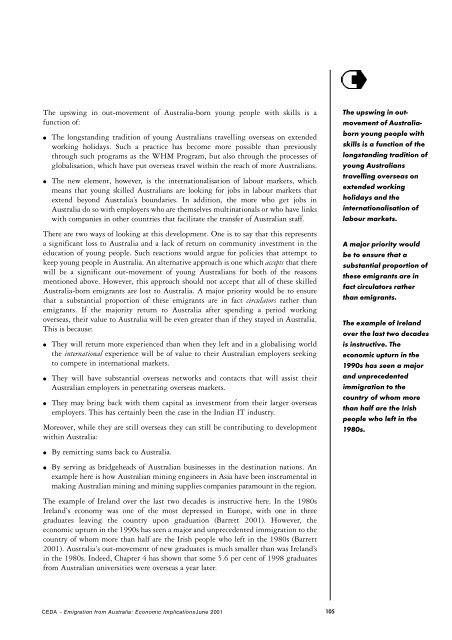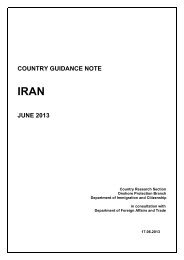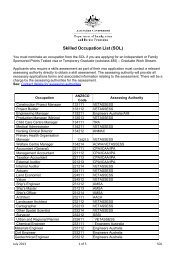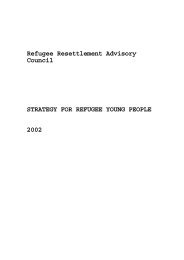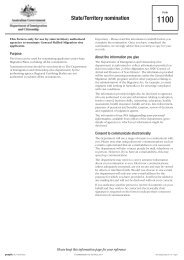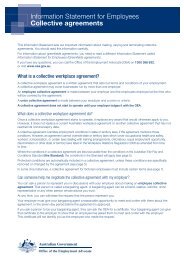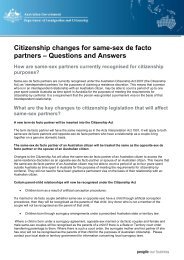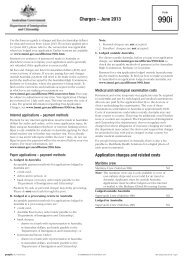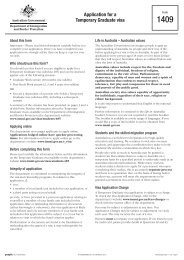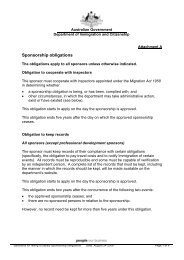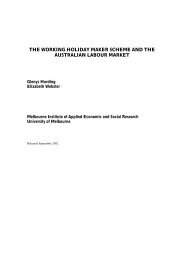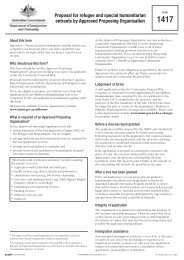part three - Department of Immigration & Citizenship
part three - Department of Immigration & Citizenship
part three - Department of Immigration & Citizenship
Create successful ePaper yourself
Turn your PDF publications into a flip-book with our unique Google optimized e-Paper software.
The upswing in out-movement <strong>of</strong> Australia-born young people with skills is a<br />
function <strong>of</strong>:<br />
●<br />
●<br />
The longstanding tradition <strong>of</strong> young Australians travelling overseas on extended<br />
working holidays. Such a practice has become more possible than previously<br />
through such programs as the WHM Program, but also through the processes <strong>of</strong><br />
globalisation, which have put overseas travel within the reach <strong>of</strong> more Australians.<br />
The new element, however, is the internationalisation <strong>of</strong> labour markets, which<br />
means that young skilled Australians are looking for jobs in labour markets that<br />
extend beyond Australia’s boundaries. In addition, the more who get jobs in<br />
Australia do so with employers who are themselves multinationals or who have links<br />
with companies in other countries that facilitate the transfer <strong>of</strong> Australian staff .<br />
There are two ways <strong>of</strong> looking at this development. One is to say that this represents<br />
a significant loss to Australia and a lack <strong>of</strong> return on community investment in the<br />
education <strong>of</strong> young people. Such reactions would argue for policies that attempt to<br />
keep young people in Australia. An alternative approach is one which accepts that there<br />
will be a significant out-movement <strong>of</strong> young Australians for both <strong>of</strong> the reasons<br />
mentioned above. However, this approach should not accept that all <strong>of</strong> these skilled<br />
Australia-born emigrants are lost to Australia. A major priority would be to ensure<br />
that a substantial proportion <strong>of</strong> these emigrants are in fact circulators rather than<br />
emigrants. If the majority return to Australia after spending a period working<br />
overseas, their value to Australia will be even greater than if they stayed in Australia.<br />
This is because:<br />
●<br />
●<br />
●<br />
They will return more experienced than when they left and in a globalising world<br />
the international experience will be <strong>of</strong> value to their Australian employers seeking<br />
to compete in international markets.<br />
They will have substantial overseas networks and contacts that will assist their<br />
Australian employers in penetrating overseas markets.<br />
They may bring back with them capital as investment from their larger overseas<br />
employers. This has certainly been the case in the Indian IT industry.<br />
Moreover, while they are still overseas they can still be contributing to development<br />
within Australia:<br />
The upswing in outmovement<br />
<strong>of</strong> Australiaborn<br />
young people with<br />
skills is a function <strong>of</strong> the<br />
longstanding tradition <strong>of</strong><br />
young Australians<br />
travelling overseas on<br />
extended working<br />
holidays and the<br />
internationalisation <strong>of</strong><br />
labour markets.<br />
A major priority would<br />
be to ensure that a<br />
substantial proportion <strong>of</strong><br />
these emigrants are in<br />
fact circulators rather<br />
than emigrants.<br />
The example <strong>of</strong> Ireland<br />
over the last two decades<br />
is instructive. The<br />
economic upturn in the<br />
1990s has seen a major<br />
and unprecedented<br />
immigration to the<br />
country <strong>of</strong> whom more<br />
than half are the Irish<br />
people who left in the<br />
1980s.<br />
●<br />
●<br />
By remitting sums back to Australia.<br />
By serving as bridgeheads <strong>of</strong> Australian businesses in the destination nations. An<br />
example here is how Australian mining engineers in Asia have been instrumental in<br />
making Australian mining and mining supplies companies paramount in the re g i o n .<br />
The example <strong>of</strong> Ireland over the last two decades is instructive here. In the 1980s<br />
Ireland’s economy was one <strong>of</strong> the most depressed in Europe, with one in <strong>three</strong><br />
graduates leaving the country upon graduation (Barrett 2001). However, the<br />
economic upturn in the 1990s has seen a major and unprecedented immigration to the<br />
country <strong>of</strong> whom more than half are the Irish people who left in the 1980s (Barrett<br />
2001). Australia’s out-movement <strong>of</strong> new graduates is much smaller than was Ireland’s<br />
in the 1980s. Indeed, Chapter 4 has shown that some 5.6 per cent <strong>of</strong> 1998 graduates<br />
from Australian universities were overseas a year later.<br />
C E DA – Emigration from Australia: Economic ImplicationsJune 2001<br />
105


